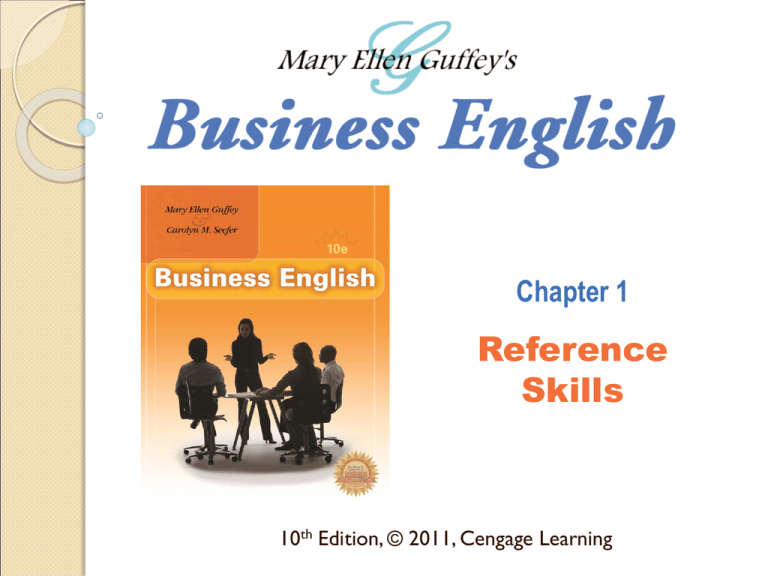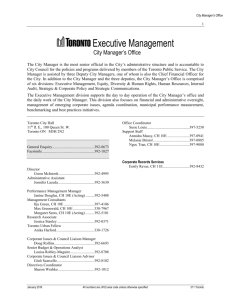
Chapter 1
Reference
Skills
10th Edition, © 2011, Cengage Learning
Orientation
How to Study Business English
Before reading a chapter
1. Set aside a quiet time and place to study.
2. Examine the chapter objectives.
3. Take the chapter pretest; check your answers.
As you read a chapter
1. Use a marker to highlight important concepts.
2. Write questions in margins to ask in class.
3. Study examples and illustrations.
Chapter 1, Guffey-Seefer, Business English, 10e, Copyright 2011 Cengage Learning, All Rights Reserved
1-2
Orientation
How to Study Business English
After reading a chapter
1. Review the passages you highlighted.
2. Ask yourself whether you understand the
concepts presented.
3. Take the posttest; compare with pretest.
4. Complete Exercise A of the reinforcement
exercises. If you have more than three
incorrect responses (out of ten), reread the
chapter.
5. Finish all the assigned exercises before
returning to class.
Chapter 1, Guffey-Seefer, Business English, 10e, Copyright 2011 Cengage Learning, All Rights Reserved
1-3
What is Business English?
Business English is the study of language
fundamentals needed to communicate
effectively in today's workplace.
These fundamentals include the following:
• Capitalization
• Grammar
• Number style
• Usage
• Spelling/Vocabulary
• Punctuation
Chapter 1, Guffey-Seefer, Business English, 10e, Copyright 2011 Cengage Learning, All Rights Reserved
1-4
Why study Business English?
• To refresh rusty skills
• To feel confident in using the language
• To succeed in a workplace where increasing
emphasis is placed on oral and written
communication
Chapter 1, Guffey-Seefer, Business English, 10e, Copyright 2011 Cengage Learning, All Rights Reserved
1-5
Can you become an expert?
Yes, you can become an expert by learning
where to find answers. You will need these
books:
• A current college-level or desk dictionary
• A good office reference manual
• Your textbook
Chapter 1, Guffey-Seefer, Business English, 10e, Copyright 2011 Cengage Learning, All Rights Reserved
1-6
Types of Dictionaries
Electronic dictionaries
◦
◦
◦
◦
At Web sites
On CD-ROM programs
In word processing programs
In handheld digital devices
Pocket dictionaries
◦ May contain up to 75,000 entries
◦ Serve as handy—but incomplete—
references
Chapter 1, Guffey-Seefer, Business English, 10e, Copyright 2011 Cengage Learning, All Rights Reserved
1-7
Types of Dictionaries
College-level or desk dictionaries
◦ May contain up to 200,000 entries
◦ Are “abridged” (shortened)
◦ Often include extra features such as language,
geographical, biographical, and measurement data.
Unabridged (complete) dictionaries
◦ May contain up to 450,000 entries
◦ Are used by professional writers, scholars
◦ May be found in libraries, schools, editorial offices
Chapter 1, Guffey-Seefer, Business English, 10e, Copyright 2011 Cengage Learning, All Rights Reserved
1-8
Ten Important Points
in Using
Your Dictionary
Chapter 1, Guffey-Seefer, Business English, 10e, Copyright 2011 Cengage Learning, All Rights Reserved
1-9
1.
2.
3.
Read the introduction to your dictionary.
Determine the order of definitions.
Use the guide words at tops of pages to help
you locate words.
Learn to distinguish among the following:
• Centered dots to show syllable breaks:
selfless
• Hyphens to show hyphenated words:
self-conscious
• Space left between words to indicate
separate words:
word processing
Chapter 1, Guffey-Seefer, Business English, 10e, Copyright 2011 Cengage Learning, All Rights Reserved
1-10
4.
Use diacritical marks to help you
pronounce a word correctly. A summary
of these special symbols is usually found
at the bottom of each set of dictionary
pages.
For example, how would you
pronounce this word?
_ _
i rate (an irate taxpayer)
Chapter 1, Guffey-Seefer, Business English, 10e, Copyright 2011 Cengage Learning, All Rights Reserved
1-11
5.
Study a word’s accent marks to learn
which syllable to stress. Primary accent
marks may precede or follow a stressed
syllable.
ob ser ‘va tion (Webster’s New Collegiate)
ob ser va’ tion (American Heritage)
Chapter 1, Guffey-Seefer, Business English, 10e, Copyright 2011 Cengage Learning, All Rights Reserved
1-12
6.
Examine a word’s etymology (word
history).
• Dictionaries that emphasize etymology
place it before the definitions.
• Square brackets [ ] enclose the word
history.
• Don’t confuse etymological definitions
with entry definitions.
Chapter 1, Guffey-Seefer, Business English, 10e, Copyright 2011 Cengage Learning, All Rights Reserved
1-13
7.
Note what part of speech a word is. Parts of
speech are usually italicized and abbreviated.
What do you think these abbreviations mean?
How can they help you learn about a word?
adj
adv
conj
interj
n
prep
pron
v or vb
vt or tr. v.
vi or intr. v.
Chapter 1, Guffey-Seefer, Business English, 10e, Copyright 2011 Cengage Learning, All Rights Reserved
1-14
8.
Labels are used in some dictionaries to
warn readers about appropriate usage.
Here are some common labels:
• archaic: words surviving from a previous
period, such as affright (terror)
• col. or inf. (colloquial or informal):
used in casual writing or conversation,
such as the word deadhead for a sluggish
person
• slang: very informal language, but may be
used for effect, such as Chill, dude!
Chapter 1, Guffey-Seefer, Business English, 10e, Copyright 2011 Cengage Learning, All Rights Reserved
1-15
8.
Labels (continued)
• Nonstandard or substandard: not
conforming to usage among educated
speakers, such as ain’t or irregardless
• dial (dialect) or Brit., West., Scot:
used in certain regions, such as the word
bonnet to mean car hood.
Chapter 1, Guffey-Seefer, Business English, 10e, Copyright 2011 Cengage Learning, All Rights Reserved
1-16
9.
Inflected forms are word forms that
change when they are used differently in
sentences, e.g., the past tense of a verb.
Most dictionaries show only irregular
changes in nouns, verbs, and adjectives.
Nouns:
Verbs:
Adjectives:
woman, women
go, went, gone
good, better, best
Chapter 1, Guffey-Seefer, Business English, 10e, Copyright 2011 Cengage Learning, All Rights Reserved
1-17
10.
Synonyms and antonyms are often
provided.
Synonyms:
words with similar meanings
ignorant — unaware (synonym)
Antonyms: words with opposite meanings
condemn — exonerate (antonym)
Chapter 1, Guffey-Seefer, Business English, 10e, Copyright 2011 Cengage Learning, All Rights Reserved
1-18
Plugging in to
Electronic Dictionaries
Electronic dictionaries are useful to do
the following:
Locate misspelled words
Find synonyms and antonyms
Spell check your documents
Chapter 1, Guffey-Seefer, Business English, 10e, Copyright 2011 Cengage Learning, All Rights Reserved
1-19
Accessing Online Dictionaries
Online and other high-tech dictionaries
are useful to do the following:
Access up-to-date vocabulary
Learn new words
Perform language translation
Hear audio pronunciations
Chapter 1, Guffey-Seefer, Business English, 10e, Copyright 2011 Cengage Learning, All Rights Reserved
1-20
Reference Manuals
Reference manuals contain helpful information
not found in dictionaries, such as the
following:
Punctuation is explained in rules accompanied by
examples.
Hyphenation rules are provided for dividing words
and for constructing compound words.
Capitalization rules are stated and illustrated.
Number style is shown.
Commonly confused words are compared.
Abbreviations and acronyms are listed and defined.
Chapter 1, Guffey-Seefer, Business English, 10e, Copyright 2011 Cengage Learning, All Rights Reserved
1-21





